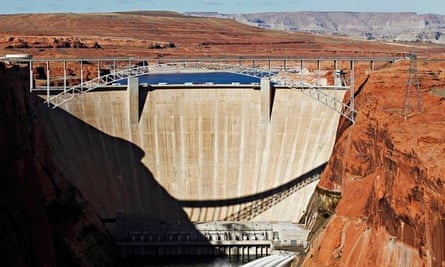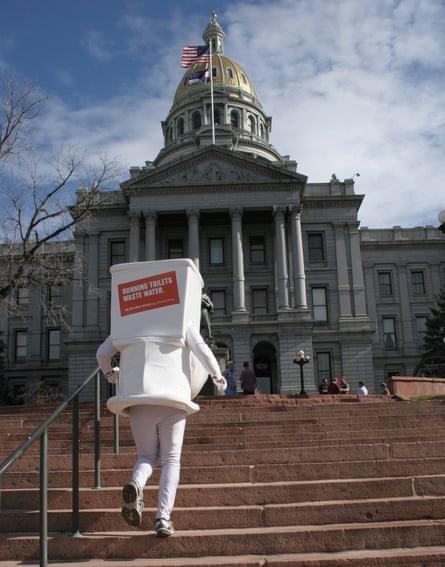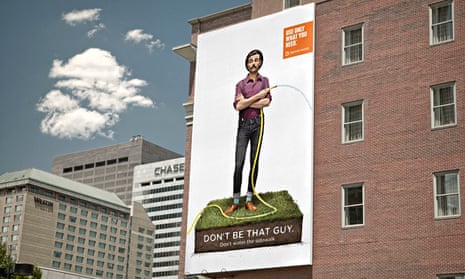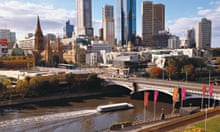“A lot of suburban water planners plan for yesterday,” says Eric Kuhn, general manager of the Colorado River Water District. But in Denver the national baby boomer vogue for suburban “ranchettes” with water-sucking lawns so big that you need a tractor to mow them is giving way to a millennial preference for downtown living in condos and lofts. SUVs are out, light rail, car and bike shares are in. And when it comes to water policy, Denver is behaving in a way that makes the future seem not only tenable but even bright.
City boosters point to an educated population but the city’s secret weapon may simply be a youthful outlook. With surrounding farmland jokingly called the “Burgundy of pot”, the Denver Post even has a column devoted to cannabis. Denver is rivalled by only Portland, Oregon, for sheer number and quality of craft breweries.
Ironically, the foundation supporting all this grooviness was laid by mid-19th-century forefathers so politically incorrect that their ideas of “Manifest Destiny” were even considered beyond the pale in their own day. As University of Colorado historian Patricia Limerick notes in A Ditch in Time, her history of Denver’s water works, Colorado’s first governor, William Gilpin, even saw the state capital as “a focal point of impregnable power in the topographical configuration of the continent”.

Railway promotions from Gilpin’s era promised west-bound settlers that “rain follows the plow”. Absurd as their ideas were, as Limerick observes, settlers drawn west by these egomaniacs did eventually succeed in harnessing water in dry places. Almost a decade before William Mulholland brought Eastern Sierra water crashing more than 200 miles south to Los Angeles, Denver had erected what in 1905 was the largest dam in the world near the eastern foothills of the Rocky Mountains on the South Platte River.
By the 1930s, Denver’s water prospectors had slipped a pipeline through a railway tunnel piercing the continental divide. Successive bores through a rib of mountains so wall-like that they divide north American drainage between the Atlantic and Pacific Oceans allowed Denver to relieve key Colorado River tributaries in the western Rockies of more than half of their flows. By 1986, Denver had diverted so much rural water from both the eastern and western sides of the divide that in his 1986 classic Cadillac Desert dam critic Marc Reisner referred to it as the “Los Angeles of the Rockies”.

In 1990, as the population served by Denver Water approached one million (this includes suburbs), plans for the Two Forks dam, a massive new project, were on the drawing board. With its 615ft-tall retaining wall, the Two Forks dam would have flooded six towns. Denver Water saw federal approval as a mere formality, and the city was even planning to pay for Two Forks without federal assistance. And then, in a shock decision, the Environmental Protection Agency under the new administration of George HW Bush, vetoed the project.
Before the Two Forks veto, across the US but particularly in the dry west, conventional wisdom had it that the only good river was a dammed one. Between hydro-power and vast reservoirs created by dams, there was arid plain, no high desert that could not be made to bloom. But, nearly a quarter of a century later, it’s clear that Two Forks was a – perhaps the – watershed moment in western water projects. The era of big infrastructure, a 20th-century drive that had left more than 30,000 dams plugging up waterways west of the Mississippi, was over. Freshwater fisheries were collapsing and with them whole ecosystems once sustained by streams and fish. The two biggest river deltas on the Pacific coast were either dead or dying. There simply wasn’t enough water to keep on damming rivers.
“That was a real game-changer for all utilities,” says Denver Water’s current manager Jim Lochhead. “We learned we needed to conserve more, we needed to reuse the water we had, we needed to use existing structures instead of building new ones.” Within his agency, Two Forks changed Denver so profoundly that, for many years afterwards, the city had environmental lawyers once more likely to sue it than do business with it on the water utility’s ruling board.
It was in 2002, however, that Denver felt the aftershock of the loss of Two Forks to its reservoir system. Colorado River snowmelt, source of half of Denver’s water, plummeted to a quarter of normal flows. Limerick relishes Denver’s response. It straight-facedly accelerated a drought-tolerant native landscape programme (Denver Water coined the phrase “xeriscaping” and opened the first demonstration garden under the name). But the rest of the alarm rang in what Limerick calls “madcap” style.

Rather than resort to predictable preaching about the virtues of conservation, something modern westerners have acquired a certain deafness to hearing, Denver hired a young local ad agency to ridicule waste. Sporting types were hired to dress up as toilets and run across fields at athletic events to broadcasts of “Don’t let your toilet run”. Print campaigns advised: “Only wash the stinky parts.” Joke-shaming is now central to the city’s conservation strategy. Denver Water’s newest effort, a “Don’t be that guy” campaign, features a NASCAR-issue dude laying on a thick carpet of turfgrass holding a flowing watering hose where his manhood should be.
Since 2002, water usage in Denver has dropped roughly 40 gallons per person per day. According to Denver Water, it now serves almost twice the population it did fifty years ago and uses only six per cent more water. For want of new dams, Denver is repurposing obsolete gravel pits to store water and has reached out to its traditional foes. Eric Kuhn’s agency representing Colorado River interests on the opposite side of the Rockies and Trout Unlimited, a powerful national alliance of anglers, a kind of Greenpeace of American freshwater fisheries, among them. In exchange for signing off on enlargement of an existing reservoir that will further drain an already dangerously sucked-dry West Slope, Kuhn and others exacted funds from Denver Water for stream restoration, agreements to keep stream flows tolerable for fish at key times, and, perhaps most importantly, a commitment that a utility dependent on profit from water sales would put a ring around its service area to reign-in sprawl.
Trout Unlimited’s Colorado executive director David Nickum meets regularly with Denver Water and has even co-authored an op-ed piece in the Denver Post with its general manager. “It’s not kumbaya all the time,” says Nickum. However, he agrees with Kuhn and even Denver Water’s CEO Jim Lochhead that the era of big infrastructure is over. It’s an accountability thing. Unlike the situation in Los Angeles, where the eastern Sierra lake devastated by “Chinatown”-era water politics is 200 miles away, Denverites consider the west slope of the Rockies their backyard. “So Denver Water is caught in the middle,” says Kuhn. “Their constituents expect them to provide high-quality, low-cost water and do it in a way that doesn’t mess up their playground.”
Interested in finding out more about how you can live better? Take a look at this month’s Live Better challenge here.
The Live Better Challenge is funded by Unilever; its focus is sustainable living. All content is editorially independent except for pieces labelled advertisement feature. Find out more here.



Comments (…)
Sign in or create your Guardian account to join the discussion